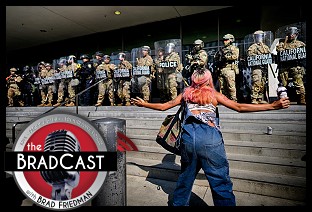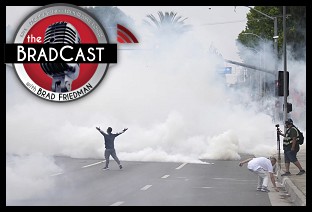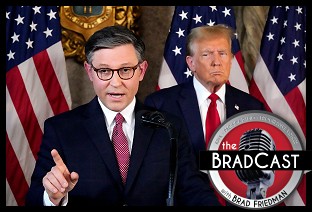

Robert F. Kennedy Jr., who filed a landmark article last June in Rolling Stone concerning evidence of a stolen 2004 Presidential Election in Ohio, is set to rock the country again in tomorrow's Rolling Stone, The BRAD BLOG can now report.
The issue is currently on the stands in some sections of LA and NY, and will be available across the nation tomorrow.
Through interviews with a number of BRAD BLOG insider sources over the past several months, Kennedy, along with co-writer Dick Russell, will expose a plethora of new details concerning the scandalous and outrageous overtaking of our public election system by private companies such Diebold, ES&S, Sequoia and others.
The article is titled: "Will The Next Election Be Hacked? - Fresh disasters at the polls --- and new evidence from an industry insider --- prove that electronic voting machines can't be trusted".
Many of the items covered may be familiar to readers here, as a good number of them were originally broken on these very pages over the last year or so. We worked closely with Kennedy and Russell on this story during its development over the past several months.
The article, however, covers several new and sometimes explosive details of Diebold's rollouts in both Georgia and Maryland dating back to 2002, as well as Florida, Ohio and Texas in 2004.
Characterizing the unchecked spread of electronic voting as "insane," Kennedy and Russell conclude, "It is time for Americans to reclaim our democracy from private interests."
Some of the damning details covered in the extensive piece include: the now-infamous and mysterious patch applied to the paperless touch-screen systems in GA just prior to the Chambliss/Cleland election; the presence of Diebold elections division president Bob Urosevich in the tabulation room in MD in 2002; Diebold's interest in downplaying, hiding the significance of several scientific reports in 2004 warning of the vulnerabilities in their machines; Rep. Bob Ney's (R-OH) involvement with former staffers and Diebold lobbyists in passing the Help America Vote Act (HAVA) through congress; ES&S shenanigans in Texas in 2004; E-Voting anomalies in Ohio and Florida may have given the election to George W. Bush; the Diebold electronic voting machine which kicked off the 2000 Presidential Election debacle...
The article is now posted in full at the RS website. Extended excerpts from the article follow below...
###
...TROUBLE COMING THIS NOVEMBER...
...
“Every board of election has staff members with the technological ability to fix an election,” Ion Sancho, an election supervisor in Leon County, Florida, told me. “Even one corrupt staffer can throw an election. Without paper records, it could happen under my nose and there is no way I’d ever find out about it. With a few key people in the right places, it would be possible to throw a presidential election.”
Much more now below...
###
...DIEBOLD TOOK OVER GEORGIA IN 2002, AND ELECTIONS STARTED FLIPPING!...
Hood wondered why Diebold, the world’s third-largest seller of ATMs, had been awarded the contract. The company had barely completed its acquisition of Global Election Systems, a voting-machine firm that owned the technology Diebold was promising to sell Georgia. And its bid was the highest among nine competing vendors. Whispers within the company hinted that a fix was in.
“The Diebold executives had a news conference planned on the day of the award,” Hood recalls, “and we were instructed to stay in our hotel rooms until just hours before the announcement. They didn’t want the competitors to know and possibly file a protest” about the lack of a fair bidding process. It certainly didn’t hurt that Diebold had political clout: Cox’s predecessor as secretary of state, Lewis Massey, was now a lobbyist for the company.
...
[Diebold] was authorized to put together ballots, program machines and train poll workers across the state – all without any official supervision. “We ran the election,” says Hood. “We had 356 people that Diebold brought into the state. Diebold opened and closed the polls and tabulated the votes. Diebold convinced Cox that it would be best if the company ran everything due to the time constraints, and in the interest of a trouble-free election, she let us do it.”
...
With the primaries looming, [Diebold Election Unit President, Bob] Urosevich was personally distributing a “patch,” a little piece of software designed to correct glitches in the computer program. “We were told that it was intended to fix the clock in the system, which it didn’t do,” Hood says. “The curious thing is the very swift, covert way this was done.”
...
“We were told not to talk to county personnel about it. I received instructions directly from Urosevich. It was very unusual that a president of the company would give an order like that and be involved at that level.”
...
"We had control of everything. The state gave us the keys to the castle, so to speak, and they stayed out of our way.” Hood personally patched fifty-six machines and witnessed the patch being applied to more than 1,200 others.
...
Six days before the vote, polls showed Sen. Max Cleland, a decorated war veteran and Democratic incumbent, leading his Republican opponent Saxby Chambliss – darling of the Christian Coalition – by five percentage points. In the governor’s race, Democrat Roy Barnes was running a decisive eleven points ahead of Republican Sonny Perdue. But on Election Day, Chambliss won with fifty-three percent of the vote, and Perdue won with fifty-one percent.
...
Hood says it was “common knowledge” within the company that Diebold also illegally installed uncertified software in machines used in the 2004 presidential primaries – a charge the company denies.
###
...POINTING OUT THAT ELECTRONIC VOTING MACHINES BEGAN THE 2000 ELECTION DEBACLE!...
Investigators traced the mistake to Global Election Systems, the firm later acquired by Diebold. Two months after the election, an internal memo from Talbot Iredale, the company’s master programmer, blamed the problem on a memory card that had been improperly – and unnecessarily – uploaded. “There is always the possibility,” Iredale conceded, “that the ‘second memory card’ or ‘second upload’ came from an unauthorized source.”
Amid the furor over hanging chads and butterfly ballots in Florida, however, the “faulty memory card” was all but forgotten. Instead of sharing culpability for the Florida catastrophe, voting-machine companies used their political clout to present their product as the solution. In October 2002, President Bush signed the Help America Vote Act, requiring states and counties to upgrade their voting systems with electronic machines and giving vast sums of money to state officials to distribute to the tightknit cabal of largely Republican vendors.
###
...REP. BOB NEY (R-OH) HAMMERS THROUGH HAVA FOR DIEBOLD LOBBYISTS, ASSOCIATES...
As The BRAD BLOG originally reported in our exposé in January, the now-disgraced congressman Bob Ney --- with help from cohorts at Diebold, including Ney's former chief of staff and Jack Abramoff's Greenburg Traurig firm --- were behind the passage of the disastrous Help America Vote Act (HAVA) from the beginning...
###
...DIEBOLD TAKES OVER MARYLAND'S ELECTION IN 2002...
“It would have been very easy for any one of us to take a contaminated card out of our pocket, put it into the system, and download some malicious code that would then end up in the server, impacting every other vote that went in, before and after,” says Hood. “We had absolute control of the tabulations. We could have fixed the election if we wanted. We had access, and that’s all you need. I can honestly say that every election I saw with Diebold in charge was compromised – if not in the count, at least in the security.”
###
...DIEBOLD SOUGHT TO HIDE PROBLEMS FOUND IN SCIENTIFIC REPORT...
But according to recent e-mails obtained by Rolling Stone, Diebold not only failed to follow up on most of the recommendations, it worked to cover them up. Michael Wertheimer, who led the RABA study, now serves as an assistant deputy director in the Office of the Director of National Intelligence. “We made numerous recommendations that would have required Diebold to fix these issues,” he writes in one e-mail, “but were rebuffed by the argument that the machines were physically protected and could not be altered by someone outside the established chain of custody.”
In another e-mail, Wertheimer says that Diebold and state officials worked to downplay his team’s dim assessment. “We spent hours dealing with Diebold lobbyists and election officials who sought to minimize our impact,” he recalls. “The results were risk-managed in favor of expediency and potential catastrophe.”
###
...E-VOTING ANOMALIES IN OHIO AND FLORIDA IN 2004 MAY HAVE GIVEN THE ELECTION TO BUSH...
The widespread glitches didn’t deter Secretary of State J. Kenneth Blackwell – who also chaired Bush’s re-election campaign in Ohio – from cutting a deal in 2005 that would have guaranteed Diebold a virtual monopoly on vote counting in the state. Local election officials alleged that the deal, which came only a few months after Blackwell bought nearly $10,000 in Diebold stock, was a violation of state rules requiring a fair and competitive bidding process. Facing a lawsuit, Blackwell agreed to allow other companies to provide machines as well. This November, voters in forty-seven counties will cast their ballots on Diebold machines – in a pivotal election in which Blackwell is running as the Republican candidate for governor.
Electronic voting machines also caused widespread problems in Florida, where Bush bested Kerry by 381,000 votes. When statistical experts from the University of California examined the state’s official tally, they discovered a disturbing pattern: “The data show with 99.0 percent certainty that a county’s use of electronic voting is associated with a disproportionate increase in votes for President Bush. Compared to counties with paper ballots, counties with electronic voting machines were significantly more likely to show increases in support for President Bush between 2000 and 2004.” The three counties with the most discrepancies – Broward, Palm Beach and Miami-Dade – were also the most heavily Democratic. Electronic voting machines, the report concluded, may have improperly awarded as many as 260,000 votes to Bush. “No matter how many factors and variables we took into consideration, the significant correlation in the votes for President Bush and electronic voting cannot be explained,” said Michael Hout, a member of the National Academy of Sciences.
###
...ES&S, HART INTERCIVIC WHISTLEBLOWER WILLIAM SINGER TALKS TEXAS...
The ES&S and Hart InterCivic whistleblower, William Singer, who The BRAD BLOG originally exposed in an exclusive in March as having tried to contact officials in both Texas and Ohio to alert them to problems (he was ignored) speaks more about what happened in Texas in 2004 [emphasis ours]...
Despite such reports, Texas continues to rely on ES&S. In primaries held in Jefferson County earlier this year, electronic votes had to be recounted after error messages prevented workers from completing their tabulations. In April, with early voting in local elections only a week away, officials across the state were still waiting to receive the programming from ES&S needed to test the machines for accuracy. Calling the situation “completely unacceptable and disturbing,” Texas director of elections Ann McGeehan authorized local officials to create “emergency paper ballots” as a backup.
###
...IN CONCLUSION...'INSANITY' AND THE BRAD BLOG...
The heartening news is, citizens are starting to fight back. Voting-rights activists with the Brad Blog and Black Box Voting are getting the word out. Voter Action, a nonprofit group, has helped file lawsuits in Arizona, New York, Pennsylvania, Colorado and New Mexico to stop the proliferation of touch-screen systems. In California, voters filed suit last March to challenge the use of a Diebold touch-screen system – a move that has already prompted eight counties to sign affidavits saying they won’t use the machines in November.
...
electronic voting machines are a hacker’s dream. And today, for-profit companies are being given unprecedented and frightening power not only to provide these machines but to store and count our votes in secret, without any real oversight.
You do not have to believe in conspiracy theories to fear for the integrity of our electoral system: The right to vote is simply too important – and too hard won – to be surrendered without a fight. It is time for Americans to reclaim our democracy from private interests.


 Sunday 'Total Obliteration' Toons
Sunday 'Total Obliteration' Toons Thank You For Your Attention to This Matter:
Thank You For Your Attention to This Matter: 'Green News Report' 6/26/25
'Green News Report' 6/26/25
 Mamdani Primary 'Win' Augurs New Generation of Progressives Rising: 'BradCast' 6/25/25
Mamdani Primary 'Win' Augurs New Generation of Progressives Rising: 'BradCast' 6/25/25 U.S. Authoritarianism Under-way (But We're Still Here to Fight It): 'BradCast' 6/24/25
U.S. Authoritarianism Under-way (But We're Still Here to Fight It): 'BradCast' 6/24/25 'Green News Report' 6/24/25
'Green News Report' 6/24/25 'Anti-War' Trump Attacks a Mid-East Nation on False Claims About WMD: 'BradCast' 6/23/25
'Anti-War' Trump Attacks a Mid-East Nation on False Claims About WMD: 'BradCast' 6/23/25  Sunday 'Peacemaker' Toons
Sunday 'Peacemaker' Toons Senate Health Care Cuts 'More Extreme' Than House Version: 'BradCast' 6/19/25
Senate Health Care Cuts 'More Extreme' Than House Version: 'BradCast' 6/19/25 'Green News Report' 6/19/25
'Green News Report' 6/19/25 What 'Anti-War President'? MAGA Civil War Over Trump, Iran: 'BradCast' 6/18/25
What 'Anti-War President'? MAGA Civil War Over Trump, Iran: 'BradCast' 6/18/25 Trump Calls for 'Remigration', a Codeword for 'Ethnic Cleansing': 'BradCast' 6/17/25
Trump Calls for 'Remigration', a Codeword for 'Ethnic Cleansing': 'BradCast' 6/17/25 'Green News Report' 6/17/25
'Green News Report' 6/17/25 Last Weekend Today: 'BradCast' 6/16/25
Last Weekend Today: 'BradCast' 6/16/25 Sunday 'Despot Times, Despot Measures' Toons
Sunday 'Despot Times, Despot Measures' Toons Then They Came for the U.S. Senators: 'BradCast' 6/12/25
Then They Came for the U.S. Senators: 'BradCast' 6/12/25 'Green News Report' 6/12/25
'Green News Report' 6/12/25 Lawless Trump Warms Up for Insurrection Act: 'BradCast' 6/11/25
Lawless Trump Warms Up for Insurrection Act: 'BradCast' 6/11/25 Trump Inciting Violence, State of Fear in L.A., Elsewhere: 'BradCast' 6/10/25
Trump Inciting Violence, State of Fear in L.A., Elsewhere: 'BradCast' 6/10/25 Nevermind Elon and Epstein Files, Trump Declares L.A. 'Riots'!: 'BradCast' 6/9/25
Nevermind Elon and Epstein Files, Trump Declares L.A. 'Riots'!: 'BradCast' 6/9/25 'Jesus Weeps' at Trump's
'Jesus Weeps' at Trump's 300k 'Preventable' Deaths Since Trump USAID Shutdown: 'BradCast' 6/4/25
300k 'Preventable' Deaths Since Trump USAID Shutdown: 'BradCast' 6/4/25 Storm Warnings: 'BradCast' 6/3/25
Storm Warnings: 'BradCast' 6/3/25 SCOTUS Ignores Own Precedents In Recent 'Emergency' Rulings: 'BradCast' 6/2/25
SCOTUS Ignores Own Precedents In Recent 'Emergency' Rulings: 'BradCast' 6/2/25 'A World of Tyrants, Bribes, and Influence': 'BradCast' 5/22/25
'A World of Tyrants, Bribes, and Influence': 'BradCast' 5/22/25
 VA GOP VOTER REG FRAUDSTER OFF HOOK
VA GOP VOTER REG FRAUDSTER OFF HOOK Criminal GOP Voter Registration Fraud Probe Expanding in VA
Criminal GOP Voter Registration Fraud Probe Expanding in VA DOJ PROBE SOUGHT AFTER VA ARREST
DOJ PROBE SOUGHT AFTER VA ARREST Arrest in VA: GOP Voter Reg Scandal Widens
Arrest in VA: GOP Voter Reg Scandal Widens ALL TOGETHER: ROVE, SPROUL, KOCHS, RNC
ALL TOGETHER: ROVE, SPROUL, KOCHS, RNC LATimes: RNC's 'Fired' Sproul Working for Repubs in 'as Many as 30 States'
LATimes: RNC's 'Fired' Sproul Working for Repubs in 'as Many as 30 States' 'Fired' Sproul Group 'Cloned', Still Working for Republicans in At Least 10 States
'Fired' Sproul Group 'Cloned', Still Working for Republicans in At Least 10 States FINALLY: FOX ON GOP REG FRAUD SCANDAL
FINALLY: FOX ON GOP REG FRAUD SCANDAL COLORADO FOLLOWS FLORIDA WITH GOP CRIMINAL INVESTIGATION
COLORADO FOLLOWS FLORIDA WITH GOP CRIMINAL INVESTIGATION CRIMINAL PROBE LAUNCHED INTO GOP VOTER REGISTRATION FRAUD SCANDAL IN FL
CRIMINAL PROBE LAUNCHED INTO GOP VOTER REGISTRATION FRAUD SCANDAL IN FL Brad Breaks PA Photo ID & GOP Registration Fraud Scandal News on Hartmann TV
Brad Breaks PA Photo ID & GOP Registration Fraud Scandal News on Hartmann TV  CAUGHT ON TAPE: COORDINATED NATIONWIDE GOP VOTER REG SCAM
CAUGHT ON TAPE: COORDINATED NATIONWIDE GOP VOTER REG SCAM CRIMINAL ELECTION FRAUD COMPLAINT FILED AGAINST GOP 'FRAUD' FIRM
CRIMINAL ELECTION FRAUD COMPLAINT FILED AGAINST GOP 'FRAUD' FIRM RICK SCOTT GETS ROLLED IN GOP REGISTRATION FRAUD SCANDAL
RICK SCOTT GETS ROLLED IN GOP REGISTRATION FRAUD SCANDAL VIDEO: Brad Breaks GOP Reg Fraud Scandal on Hartmann TV
VIDEO: Brad Breaks GOP Reg Fraud Scandal on Hartmann TV RNC FIRES NATIONAL VOTER REGISTRATION FIRM FOR FRAUD
RNC FIRES NATIONAL VOTER REGISTRATION FIRM FOR FRAUD EXCLUSIVE: Intvw w/ FL Official Who First Discovered GOP Reg Fraud
EXCLUSIVE: Intvw w/ FL Official Who First Discovered GOP Reg Fraud GOP REGISTRATION FRAUD FOUND IN FL
GOP REGISTRATION FRAUD FOUND IN FL

































